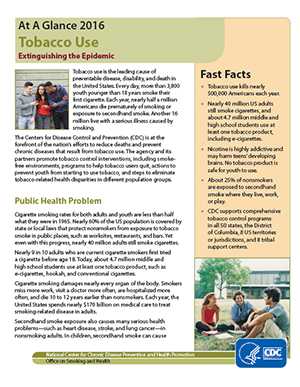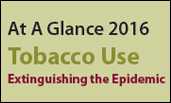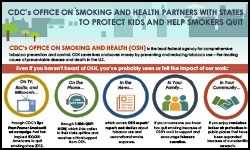Office on Smoking and Health (OSH)
Tobacco use is the leading cause of preventable disease, disability, and death in the United States. Every day, more than 3,800 youth younger than 18 years smoke their first cigarette. Each year, nearly half a million Americans die prematurely of smoking or exposure to secondhand smoke. Another 16 million live with a serious illness caused by smoking. The United States spends nearly $170 billion on medical care to treat smoking-related disease in adults each year.
The Centers for Disease Control and Prevention (CDC) is at the forefront of the nation’s efforts to reduce deaths and prevent chronic diseases that result from tobacco use. The agency and its partners promote tobacco control interventions, including actions to prevent youth from starting to use tobacco, smoke-free environments, programs to help tobacco users quit, and steps to eliminate tobacco-related health disparities in different population groups.
Mission
To develop, conduct, and support strategic efforts to protect the public’s health from the harmful effects of tobacco use.
Vision
A world free from tobacco-related death and disease.
Goals
- Prevent initiation of tobacco use among youth and young adults
- Promote quitting among adults and youth
- Eliminate exposure to secondhand smoke
- Identify and eliminate tobacco-related disparities
Partnerships and Actions
To accomplish our goals, we work in partnership with local, state, national, and international leaders to—
- Expand the science base of effective tobacco control
- Build sustainable capacity and infrastructure for comprehensive tobacco control programs
- Communicate timely, relevant information to constituents, policy makers, and the public
- Coordinate policy, partnerships, and other strategic initiatives to support tobacco control priorities
- Foster global tobacco control through surveillance, capacity building, and information exchange
Key Activities
CDC works with decision makers, partners, health officials, and the public to end the tobacco epidemic by:
- Supporting comprehensive tobacco prevention and control programs in all 50 states, the District of Columbia, 8 US territories or jurisdictions, and 12 tribal organizations
- Supporting tobacco cessation and quitline services in 50 states, two territories, and Washington, D.C., and maintaining the national network of tobacco cessation quitlines
- Educating the public about the harms of tobacco use, including through paid media campaigns like Tips From Former Smokers
- Conducting and coordinating surveillance, laboratory, and evaluation activities related to tobacco use and its effect on health
- Reducing tobacco-related health disparities through 8 national networks working to reduce tobacco use among specific populations
- Supporting health systems to improve cessation insurance coverage, remove barriers to evidence-based cessation treatments, and promote use of covered treatments
- Coordinating the Interagency Committee on Smoking and Health
- Strengthening global tobacco surveillance systems to monitor the global tobacco epidemic*
* CDC’s global tobacco work is supported by the CDC Foundation through donations from the Bloomberg Initiative to Reduce Tobacco Use and The Bill and Melinda Gates Foundation.
- Page last reviewed: July 11, 2017
- Page last updated: July 11, 2017
- Content source:


 ShareCompartir
ShareCompartir








